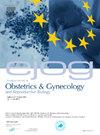Normalization of subendometrial peristalsis in women with a large uterine niche following laparoscopic niche repair: A prospective cohort study
IF 2.1
4区 医学
Q2 OBSTETRICS & GYNECOLOGY
European journal of obstetrics, gynecology, and reproductive biology
Pub Date : 2025-02-18
DOI:10.1016/j.ejogrb.2025.02.033
引用次数: 0
Abstract
Objective
To study the impact of laparoscopic niche repair on subendometrial peristalsis in women with a large niche.
Methods
A explorative prospective cohort study that included women with a large niche (residual myometrium ≤ 3 mm), actual wish to conceive who were scheduled for laparoscopic niche repair. To analyse the effect of a laparoscopic niche repair on the uterine anatomy and subendometrial peristalsis, all participants underwent a 4–5 min transvaginal ultrasound before surgery and three months post-surgery during the mid-luteal phase of the menstrual cycle. Subendometrial peristalsis was evaluated by strain analysis using a dedicated two-dimensional optical flow speckle tracking method. The following features were extracted from the strain signals: frequency, amplitude, velocity, coordination and direction of coordination.
Results
Post-surgery, the mean niche volume significantly decreased, with a mean reduction of 963.9 mm3 (95 % CI 382.0–1545.7). Additionally, the residual myometrium thickness increased significantly, with a mean difference of 5.8 mm (95 % CI 6.8 to 4.7). Of the subendometrial peristalsis, a significant improvement of the frequency was observed. Although amplitude, velocity, and direction of the contractions shifted towards normal values, these changes did not reach statistical significance in this pilot study. The improvements in individual peristaltic characteristics were closely associated with reductions in niche volume and enlargement of residual myometrium.
Conclusion
Subendometrial peristalsis is disturbed in women with a large niche. Individual contraction parameters such as velocity, amplitude and frequency decreased following laparoscopic niche repair which might be favourable for fertility purposes. These changes were associated with a reduction in niche volume and enlargement of the residual myometrium and warrant further validation in a larger cohort study.
求助全文
约1分钟内获得全文
求助全文
来源期刊
CiteScore
4.60
自引率
3.80%
发文量
898
审稿时长
8.3 weeks
期刊介绍:
The European Journal of Obstetrics & Gynecology and Reproductive Biology is the leading general clinical journal covering the continent. It publishes peer reviewed original research articles, as well as a wide range of news, book reviews, biographical, historical and educational articles and a lively correspondence section. Fields covered include obstetrics, prenatal diagnosis, maternal-fetal medicine, perinatology, general gynecology, gynecologic oncology, uro-gynecology, reproductive medicine, infertility, reproductive endocrinology, sexual medicine and reproductive ethics. The European Journal of Obstetrics & Gynecology and Reproductive Biology provides a forum for scientific and clinical professional communication in obstetrics and gynecology throughout Europe and the world.

 求助内容:
求助内容: 应助结果提醒方式:
应助结果提醒方式:


